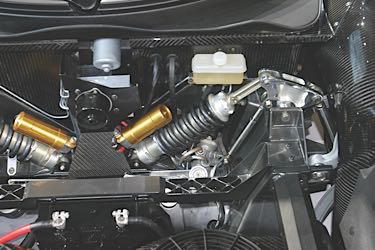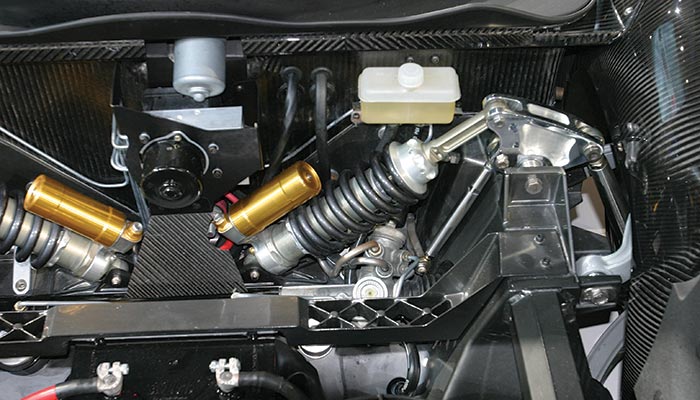 Installing performance suspension components can be a deal with the devil when it comes to creating a vehicle that the customer can live with every day or, at least, on the way to the track or car show.
Installing performance suspension components can be a deal with the devil when it comes to creating a vehicle that the customer can live with every day or, at least, on the way to the track or car show.
The secret with this job is building the total package that optimizes the chassis, springs and ride control components. Often, a project vehicle is pieced together from different parts that might be the best on the market, but not necessarily the best for the other modifications. It is all about balance.
Basics
Cornering or lateral acceleration causes the chassis to roll. The faster the corner, the more the chassis will tend to roll. During a cornering maneuver, the weight distribution of the entire vehicle changes and is transferred around the four corners.
In a right-hand corner, the most weight is placed on the left front wheel. The right rear wheel carries the least amount of weight. If the vehicle is braking in the corner, even more weight is shifted to the right front wheel.
Weight transfer is a good thing when it comes to generating grip. But, weight transfer can cause the suspension to compress. When the suspension compresses, the suspension angles (camber and toe) change and alter the footprint of the tire. Some of the angle changes can help improve grip, but past a certain point, they can reduce the contact patch of the tire.
Chassis roll is another factor in chassis dynamics. As a vehicle corners or accelerates, the chassis or body will roll and compress the suspension. The amount of chassis roll is not only determined by the type of maneuver, but also by where the weight is in the vehicle along with how much the suspension compresses. Vehicles with a higher center of gravity will have more body roll, and under braking, will transfer more weight to the front tires. This is why BMW is using carbon fiber for the roof, hood and trunk lid. Body roll is bad because it changes the location of the suspension mounting points in reference to the road. This changes the camber and toe.
Shock & Struts
To understand performance shocks and struts, it is critical to understand compression and rebound. Increasing the compression setting of a shock or strut increases the amount of force needed to compress the unit. Increasing the rebound setting increases the amount of force needed to extend the unit. On some units, compression and rebound are tuned for low- and high-frequency suspension movements. Most non-adjustable performance shocks and struts will have more rebound when compared to the stock unit. This is done to control the spring and prevent unwanted weight transfer.
Setting an adjustable unit to the maximum settings for compression and rebound does not make for the best handling vehicle. The settings should be set for the spring, body roll and desired handling characteristics. Settings for the front and rear will be different.
Even though the shocks and struts are not physically connected, physics and various forces do connect them. When a shock is out of specification at one end, it will influence the weight transfer and handling at the other end or opposite corner. Both the race mechanic and engineer are trying to strike a balance between being “push” and being “loose.” They are also trying to make sure the settings are optimal for a variety of conditions and surfaces.
This imbalance can be experienced if the vehicle has to do a panic stop and sudden lane change. When the weight loads the front tires, the rear spring expands, which makes the contact patch of the rear tire smaller. If the shock or strut is unable to control the rebound of the spring, additional weight is transferred to the front, which can cause the vehicle to nosedive even more.
During a panic stop, the vehicle becomes unstable if it needs to swerve to avoid something in its path. The front tires have all the traction, while the rear tires have very little. This usually results in an oversteer or understeer condition that leads to a loss of control.
Springs
Lowering springs are available for many applications. These springs can be purchased with varying amounts of lowering ability, ranging from one to three inches. They can make a difference in handling by lowering the center of gravity and preventing body roll. But, don’t expect huge increases in spring rates because they still have to work with the stock and upgraded shocks or struts. If you install new springs on worn shocks or struts, the stronger springs will overpower the rebound and compression dampening capabilities and make the ride and handling even worse.
Another factor to consider is the amount of expected suspension drop. Often, a set of lowering springs are installed and there is no difference in ride height. Why? The original springs were worn out and the suspension was already lowered.
Sway/Anti-Roll Bars
Often, the most overlooked suspension modifications are sway or anti-roll bars. Anti-roll bars work like springs with levers that only work when the chassis rolls. Bars attach to the chassis and then links connect them to the lower control arms or struts. The change in position of the control arms will cause the bar to lift the chassis on one side and pull it down on the other depending on the direction of the turn.
The stiffness of the bar depends on its thickness and the length of the arms. Some bars have a hollow construction to decrease weight and improve stiffness. Some performance bars even have additional mounting holes to adjust stiffness.
Anti-roll bars have the advantage of minimally compromising ride quality in a straight line. Often, just upgrading the bars in the front and rear will improve mechanical grip more than springs on some vehicles. In some cases, upgraded bars will negate the need for stiffer springs.
The Complete Package
The first consideration with any suspension modification is the customer. It is very important to understand what the customer wants from the vehicle and how they want to use it. Often, the best modification is return the vehicle to like-new condition.














